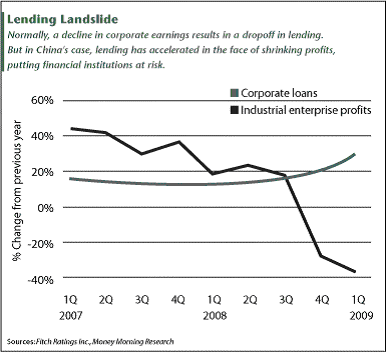With the implementation of a $585 billion stimulus program, Chinese policymakers have managed to compensate for a huge drop in exports, which to this point have been the lifeblood of China’s economy.
But by giving state-run banks the task of financing the massive amounts of infrastructure spending contained in the stimulus package, Beijing has exposed the country’s financial sector in a way that could short-circuit that country’s ongoing economic rebound.
China’s gross domestic product (GDP) expanded 6.1% in the first quarter, the weakest pace in nearly a decade. In an effort to reinvigorate the economy and capture the 8% annual growth Beijing promised at the beginning of the year, the government in November unveiled the half-trillion-dollar stimulus, the bulk of which was designed to create domestic demand.
Investments in such tangible projects as roads, factories and houses rose 32.9% in the first five months of the year, according to China’s National Bureau of Statistics. Investments initiated by the central government were up by 28% in the January-May period, while those carried out by local governments rose 33.4%.
Also key:
- Real estate investment grew 6.8%.
- Capital spending in primary industries rose 79.7%.
- Investment in railways rose 110.9%.
This investment clearly filtered through the economy in May as industrial output and retail sales surged. Industrial output accelerated to 8.9% and retail sales soared 15.2%, the statistics bureau said.
China’s property market also continued to flourish. Sales rose 45.3% to $146 billion (1 trillion yuan) in the first five months of 2009 compared with the same period last year, and real estate investment grew at a quicker 6.8% rate. Sales grew 35.4% in the first four months. Real estate prices rose 0.6% from April to May, the third consecutive monthly increase.
“As developers run down inventory rapidly, they will soon start to buy land and increase spending again,” Frank Gong, chief China economist and strategist at JPMorgan Chase & Co. (JPM: 32.73 -0.77 -2.30%) in Hong Kong, told Bloomberg News. “Property investment, which accounts for 10% of China’s GDP and is a trigger for growth in related sectors, will become a strong driving force in China’s recovery.”
Goldman Sachs Group Inc. (GS: 139.73 -4.43 -3.07%), UBS Securities AG (UBS: 13.08 -0.20 -1.51%), and Morgan Stanley (MS: 27.48 -0.62 -2.21%) all raised their economic forecasts for China’s economy in light of the positive news.
Goldman Sachs boosted its forecast for China’s GDP growth from 6% to 8.3%. UBS Securities boosted its target from 6.5% to between 7% and 7.5% growth. And Morgan Stanley raised it estimate from 5.5% to 7%.
Indeed, the spurt of economic activity has been staggering, and many analysts believe China will carry this momentum forward and experience a ‘U’-shaped economic recovery, or possibly even a robust ‘V’-shaped rebound. But there is also the potential for an economic collapse that could undo all of the nation’s progress to this point.
Will a Recovery be Swamped in a Lending Landslide?
Government intervention has spurred investment, but it has also unleashed a torrent of lending that is not necessarily justified by current economic conditions.
Lending in the first five months of the year totaled $854 billion (5.84 trillion yuan). That exceeds the $718 billion (4.91 trillion yuan) in loans made in all of 2008. New loans in May alone hit $97.22 billion (664.5 billion yuan) - more than double the ($46.6 billion) 318.5 billion yuan doled out a year ago.
The rapid growth of lending has been a red flag for many analysts who are worried about the quality of Chinese loans.
“The rapid growth of credit should be regarded as a warning sign,” Andrew Crockett, a member of the China Banking Regulatory Commission’s international advisory committee, told Bloomberg. “Nearly always when we have financial difficulties at banking institutions, it’s preceded by rapid growth in lending.”
Crockett is also JPMorgan’s international president.
With interest rates low, the only way for China’s banks to reach their profit targets has been to increase the number of loans they make both to consumers and corporate clients. But the banks they are doing so at a time when corporate profits have been eviscerated by a severe drop in exports.

“Ordinarily, falling corporate earnings are met with tightened lending, but in China precisely the reverse is happening,” Fitch Ratings Inc. said in a report last month. “This illustrates that “despite years of reform Chinese banks still retain an important policy function in upholding local enterprises.”
Fitch said that it is “increasingly wary” of China’s banking system and that it expects an increase in bad debts. The ratings agency pointed to several “early warning signals” that indicate the quality of loans may be deteriorating.
One sign is that banks are increasing the amount of money that’s kept aside to protect against unimpaired loans. That suggests lenders expect losses from loan defaults to increase. Banks are also downgrading more “special-mention” loans to nonperforming status.
Additionally, foreign banks with operations in China, which have better risk-management systems, have seen an increase in nonperforming loans.
Ma Jun, chief China economist at Deutsche Bank AG (DB: 59.86 -1.07 -1.76%) in Hong Kong, is one of the analysts who sees a ‘V’-shaped recession for China. But he still says that bank lending is nearing dangerous levels.
“The pace of bank lending is dangerous and the risks include inflation, bad loans, and economic volatility,” he told Bloomberg.
But according to Fitch, any potential credit crisis will be hard to spot in the short-term, because of the high volume of lending. Over time, though, as the global economic downturn wears on, a lack of domestic demand and declining corporate earnings could lead to a sharp spike in defaults.



